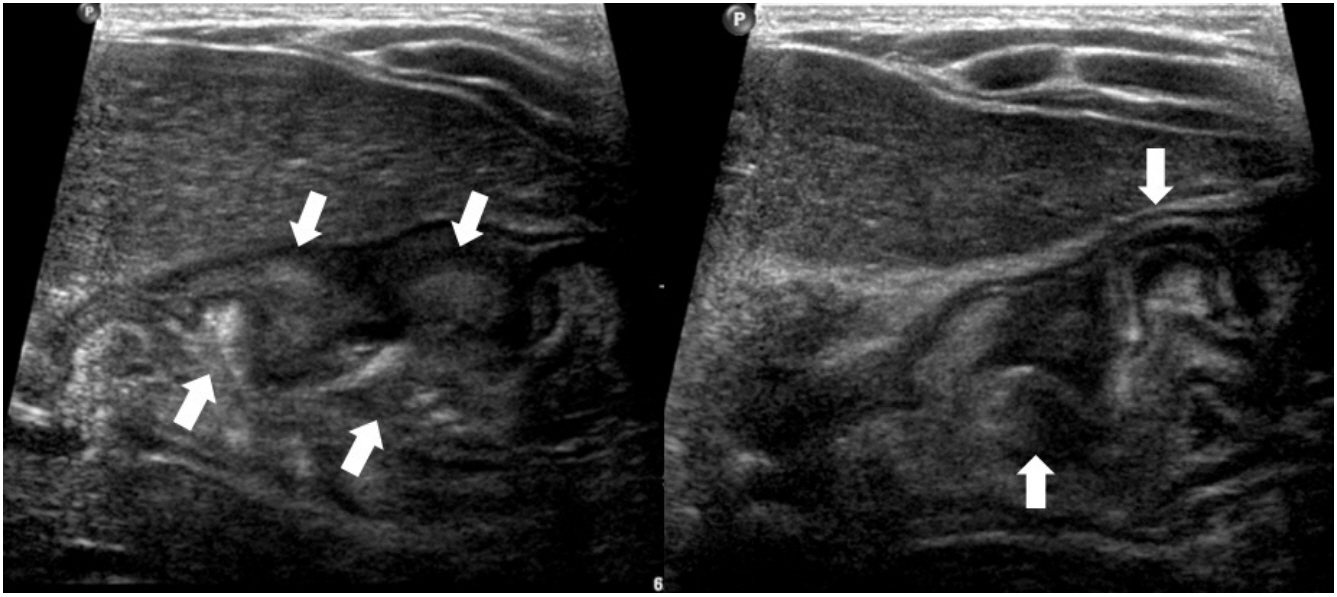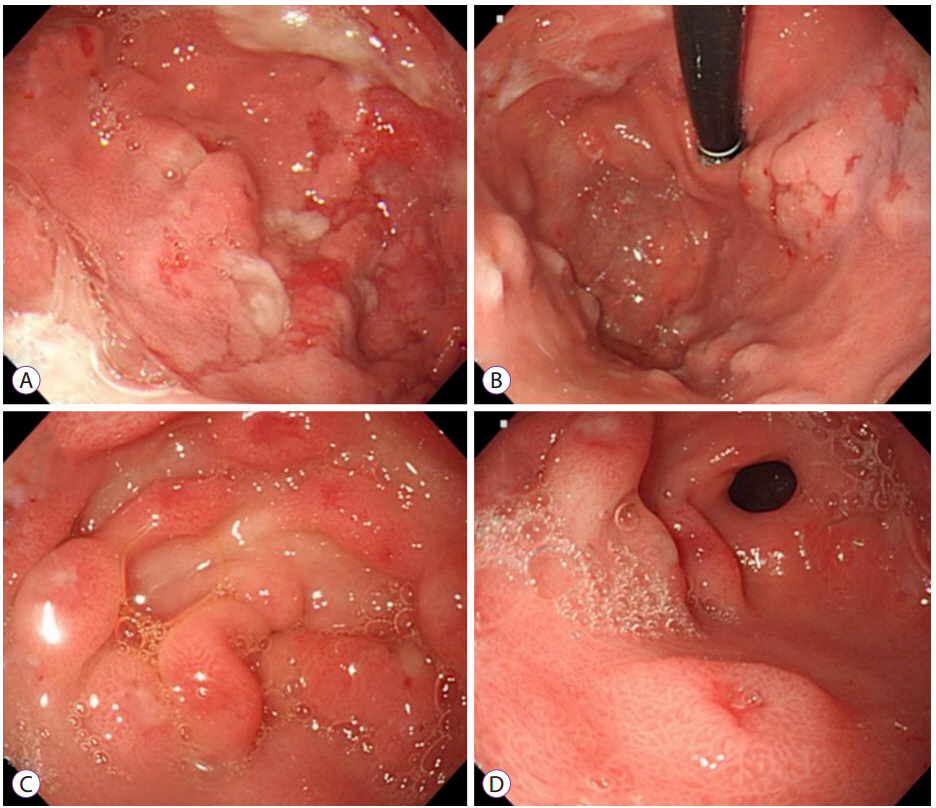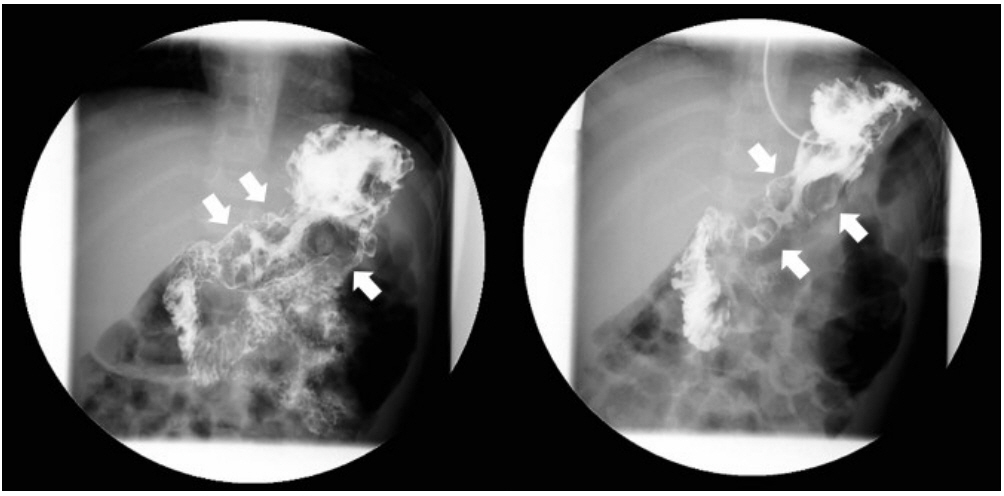Clin Endosc.
2018 Jan;51(1):89-94. 10.5946/ce.2017.038.
Ménétrier’s Disease as a Gastrointestinal Manifestation of Active Cytomegalovirus Infection in a 22-Month-Old Boy: A Case Report with a Review of the Literature of Korean Pediatric Cases
- Affiliations
-
- 1Department of Pediatrics, Kangwon National University Hospital, Kangwon National University School of Medicine, Chuncheon, Korea. jnhongmd@gmail.com
- 2Department of Anatomic pathology, Kangwon National University Hospital, Kangwon National University School of Medicine, Chuncheon, Korea.
- 3Department of Anesthesiology, Kangwon National University Hospital, Kangwon National University School of Medicine, Chuncheon, Korea.
- KMID: 2403638
- DOI: http://doi.org/10.5946/ce.2017.038
Abstract
- Ménétrier's disease (MD), which is characterized by hypertrophic gastric folds and foveolar cell hyperplasia, is the most common gastrointestinal (GI) cause of protein-losing enteropathy (PLE). The clinical course of MD in childhood differs from that in adults and has often been reported to be associated with cytomegalovirus (CMV) infection. We present a case of a previously healthy 22-month-old boy presenting with PLE, who was initially suspected to have an eosinophilic GI disorder. However, he was eventually confirmed, by detection of CMV DNA using polymerase chain reaction (PCR) with gastric tissue, to have MD associated with an active CMV infection. We suggest that endoscopic and pathological evaluation is necessary for the differential diagnosis of MD. In addition, CMV DNA detection using PCR analysis of biopsy tissue is recommended to confirm the etiologic agent of MD regardless of the patient's age or immune status.
Keyword
MeSH Terms
Figure
Reference
-
1. Vandenplas Y. Menetrier disease. In : Guandalini S, Dhawan A, Branski D, editors. Textbook of pediatric gastroenterology, hepatology and nutrition. Switzerland: Springer International Publishing;2016. p. 157–158.2. Megged O, Schlesinger Y. Cytomegalovirus-associated protein-losing gastropathy in childhood. Eur J Pediatr. 2008; 167:1217–1220.
Article3. Cieslak TJ, Mullett CT, Puntel RA, Latimer JS. Menetrier’s disease associated with cytomegalovirus infection in children: report of two cases and review of the literature. Pediatr Infect Dis J. 1993; 12:340–343.4. Patra S, Samal SC, Chacko A, Mathan VI, Mathan MM. Cytomegalovirus infection of the human gastrointestinal tract. J Gastroenterol Hepatol. 1999; 14:973–976.
Article5. Ko HM, Morotti RA, Yershov O, Chehade M. Eosinophilic gastritis in children: clinicopathological correlation, disease course, and response to therapy. Am J Gastroenterol. 2014; 109:1277–1285.
Article6. Dempsey PJ, Goldenring JR, Soroka CJ, et al. Possible role of transforming growth factor alpha in the pathogenesis of Ménétrier’s disease: supportive evidence form humans and transgenic mice. Gastroenterology. 1992; 103:1950–1963.7. Wang X, Huong SM, Chiu ML, Raab-Traub N, Huang ES. Epidermal growth factor receptor is a cellular receptor for human cytomegalovirus. Nature. 2003; 424:456–461.
Article8. Sferra TJ, Pawel BR, Qualman SJ, Li BU. Ménétrier disease of childhood: role of cytomegalovirus and transforming growth factor alpha. J Pediatr. 1996; 128:213–219.
Article9. Chetty R, Roskell DE. Cytomegalovirus infection in the gastrointestinal tract. J Clin Pathol. 1994; 47:968–972.
Article10. Umar SB, DiBaise JK. Protein-losing enteropathy: case illustrations and clinical review. Am J Gastroenterol. 2010; 105:43–49. quiz 50.
Article11. Trout AT, Dillman JR, Neef HC, Rabah R, Gadepalli S, Geiger JD. Case 189: pediatric Ménétrier disease. Radiology. 2013; 266:357–361.
Article12. Rich A, Toro TZ, Tanksley J, et al. Distinguishing Ménétrier’s disease from its mimics. Gut. 2010; 59:1617–1624.
Article13. Takeyama J, Abukawa D, Miura K. Eosinophilic gastroenteritis with cytomegalovirus infection in an immunocompetent child. World J Gastroenterol. 2007; 13:4653–4654.
Article14. Lim YJ, Rhee PL, Kim YH, et al. Clinical features of Menetrier’s disease in Korea. Korean J Gastrointest Endosc. 2000; 21:909–916.15. Suter WR, Neuweiler J, Borovicka J, Binek J, Fantin AC, Meyenberger C. Cytomegalovirus-induced transient protein-losing hypertrophic gastropathy in an immunocompetent adult. Digestion. 2000; 62:276–279.
Article16. Cho JR, Kang SK, Kim YH, Choe YH. A case of Menetrier’s disease associated with cytomegalovirus infection. Korean J Pediatr. 2001; 44:1197–1200.17. Choi WJ, Lee BY, Lee HJ, Oh HK, Hwang JB. Cytomegalovirus-induced childhood Menetrier’s disease with peripheral eosinophilia. Korean J Pediatr Gastroenterol Nutr. 2004; 7:87–91.
Article18. Son KH, Kwak JJ, Park JO. A case of cytomegalovirus-negative Ménétrier’s disease with eosinophilia in a child. Korean J Pediatr. 2012; 55:293–296.
Article19. Yoo Y, Lee Y, Lee YM, Choe YH. Co-infection with cytomegalovirus and helicobacter pylori in a child with Ménétrier’s disease. Pediatr Gastroenterol Hepatol Nutr. 2013; 16:123–126.20. Yoon J, Ahn MB, Maeng L-S, Kim SY. A case of pediatric Ménétrier’s disease associated with helicobacter pylori infection. Korean J Helicobacter Up Gastrointest Res. 2014; 14:288–291.
- Full Text Links
- Actions
-
Cited
- CITED
-
- Close
- Share
- Similar articles
-
- A case of esophagitis and p erinatal cytomegalovirus infection
- Cytomegalovirus Induced Gastric Ulcer as a Principal Manifestation in the Initial Stage of Hodgkin's Disease
- A Case of Inherited Thymic Dysplasia Associated with Disseminated Cytomegalovirus Infection
- Severe Cytomegalovirus Infection in a Late-Preterm Infant at 2 Months of Age
- A study of neonatal cholestasis and cytomegalovirus infection






